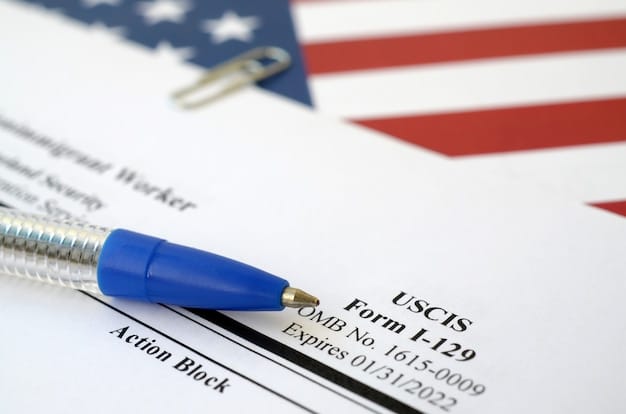Unlock $2,000 with the Lifetime Learning Credit in 2025

The Lifetime Learning Credit (LLC) offers up to $2,000 in tax breaks for eligible education expenses, making higher education more accessible. Discover how to qualify, claim the credit, and maximize your savings for courses taken towards a degree or to improve job skills in 2025.
Navigating the world of tax credits can seem daunting, but the Lifetime Learning Credit: Boosting Your Education with a $2,000 Tax Break in 2025 offers a significant financial boost for those pursuing higher education or job-related courses. This credit can help offset the costs of tuition, fees, and other educational expenses, making lifelong learning more accessible and affordable.
Understanding the Lifetime Learning Credit
The Lifetime Learning Credit (LLC) is a valuable tax benefit designed to support individuals pursuing further education or skills enhancement. Unlike some credits that are limited to specific degree programs, the LLC is much broader in scope, making it relevant for a wide range of students and professionals.
What is the Lifetime Learning Credit?
The LLC is a nonrefundable tax credit, which means it can reduce your tax liability to $0, but you won’t receive the unused portion back as a refund. The credit is worth up to $2,000 per tax return, which is calculated as 20% of the first $10,000 in educational expenses.
Who is Eligible?
Eligibility for the Lifetime Learning Credit depends on several factors, including the student’s enrollment status, the type of educational institution, and the purpose of the coursework. To qualify, the student must be:
- Enrolled at an eligible educational institution.
- Taking courses to acquire job skills or to obtain a degree.
- Meeting certain income requirements.

The Lifetime Learning Credit supports lifelong learning by providing tax relief for a variety of educational endeavors, from degree programs to skill-enhancing courses. It aims to ease the financial burden of education and promote continuous professional development.
Qualifying Education Expenses for the LLC
Understanding which expenses qualify for the Lifetime Learning Credit is essential to maximizing your tax benefits. Not all educational costs are eligible, so knowing the specific criteria can help you document and claim the credit accurately.
Tuition and Fees
The primary qualifying expenses for the Lifetime Learning Credit are tuition and mandatory fees. These include the direct costs of enrollment and instruction at an eligible educational institution.
Required Course Materials
In some cases, the cost of books, supplies, and equipment required for your courses may also qualify for the Lifetime Learning Credit. However, these materials must be required as a condition of enrollment or attendance. This means that if the materials are optional or not specifically mandated by the course, they may not be eligible.
Qualifying education expenses are the costs directly related to enrollment and attendance at an eligible institution, including tuition, fees, and required course materials. Ensuring these expenses are documented will help when claiming the Lifetime Learning Credit.
Income Limits and Phase-Outs
The Lifetime Learning Credit is subject to income limits, which means your eligibility to claim the full credit amount may be affected by your adjusted gross income (AGI). Understanding these income thresholds and phase-out ranges is crucial for determining how much you can claim.
AGI Thresholds
For the Lifetime Learning Credit, the amount you can claim starts to decrease if your modified adjusted gross income (MAGI) is above a certain threshold. These limits are adjusted annually, so it’s important to refer to the most recent IRS guidelines.
Phase-Out Range
The phase-out range is the income level at which the credit gradually decreases until it’s completely eliminated. Taxpayers with income within this range can only claim a partial credit.
- Check IRS guidelines for the most current AGI and MAGI limits.
- Understand how the phase-out range affects the amount of credit you can claim.
- Consider strategies to manage your income to maximize tax benefits.

Income limits and phase-outs play a significant role in determining eligibility for the Lifetime Learning Credit. Staying informed about these limits can help you plan your finances and optimize your tax benefits.
How to Claim the Lifetime Learning Credit
Claiming the Lifetime Learning Credit involves several steps, including gathering the necessary documentation and completing the appropriate tax forms. A clear understanding of this process ensures you can claim the credit accurately and efficiently.
Required Documentation
To claim the Lifetime Learning Credit, you’ll need to provide documentation of your qualifying education expenses. This includes:
- Form 1098-T: Tuition Statement provided by the educational institution.
- Receipts: Records of tuition payments, fees, and required course materials.
Completing Form 8863
The Lifetime Learning Credit is claimed by completing Form 8863, Education Credits (American Opportunity and Lifetime Learning Credits). This form requires you to provide information about the student, the educational institution, and the qualifying expenses.
Filing Your Tax Return
Once you’ve completed Form 8863, you’ll need to attach it to your tax return (Form 1040). Ensure that all information is accurate and that you’ve included all required documentation to avoid delays or issues with your tax return.
Claiming the Lifetime Learning Credit involves careful documentation and accurate completion of tax forms. By following these steps, you can ensure you receive the tax benefits you’re entitled to.
Maximizing Your Lifetime Learning Credit
To get the most out of the Lifetime Learning Credit, consider the timing of educational expenses and explore other tax benefits that may be available to you.
Timing of Expenses
You can only claim the Lifetime Learning Credit for expenses paid during the tax year. If you have some flexibility, try to pay for tuition, fees, and required materials in whichever year gives you the best tax advantage. For instance, if your income is expected to be lower in the following year, consider deferring payment if possible.
Coordination with Other Education Benefits
Keep in mind that you can’t claim both the Lifetime Learning Credit and the American Opportunity Tax Credit (AOTC) for the same student in the same tax year. Also, if you’re using funds from a tax-free education savings account, you can’t claim the Lifetime Learning Credit for the same expenses.
Maximizing your Lifetime Learning Credit involves strategic planning and an understanding of how it interacts with other tax benefits. Careful timing of expenses and coordination with other credits can help you reduce your tax liability.
The Impact of the LLC on Your Finances
The Lifetime Learning Credit can have a significant impact on your overall financial situation by reducing the burden of educational expenses. Understanding how this credit works and how to claim it can help you make informed decisions about your education and finances.
Reducing Tax Liability
By claiming the Lifetime Learning Credit, you can directly reduce the amount of taxes you owe. This can free up funds for other important expenses or investments.
Encouraging Lifelong Learning
The availability of the Lifetime Learning Credit encourages individuals to pursue further education and skills enhancement. This can lead to improved job prospects, higher earning potential, and greater career satisfaction.
The Lifetime Learning Credit offers substantial financial benefits for eligible taxpayers, making education more accessible and promoting lifelong learning. By understanding and utilizing this credit effectively, you can improve your financial well-being and invest in your future.
| Key Point | Brief Description |
|---|---|
| 🎓 Credit Value | Up to $2,000, based on 20% of the first $10,000 in education expenses. |
| ✅ Eligibility | Enrolled in an eligible institution, taking courses for job skills or a degree. |
| 💰 Qualified Expenses | Tuition, mandatory fees, and required course materials. |
| 📑 Claiming | Use Form 8863, Education Credits, and attach to your Form 1040. |
Frequently Asked Questions (FAQ)
▼
The Lifetime Learning Credit (LLC) is a tax credit that can help pay for degree courses, as well as courses taken to improve job skills. It is worth up to $2,000 per tax return.
▼
You are eligible if you are enrolled at an eligible educational institution and taking courses to acquire job skills or to obtain a degree. There are also income limitations.
▼
Qualifying expenses include tuition, mandatory fees, and required course materials. The expenses must be directly related to enrollment and attendance at an eligible institution.
▼
You claim the Lifetime Learning Credit by completing Form 8863, Education Credits, and attaching it to your tax return (Form 1040). Keep all your documentation of expenses.
▼
No, you cannot claim both the Lifetime Learning Credit and the American Opportunity Tax Credit for the same student in the same tax year. You mustchoose one.
Conclusion
The Lifetime Learning Credit is a valuable resource for individuals seeking to further their education or enhance their job skills. By understanding the eligibility requirements, qualifying expenses, and how to claim the credit, you can effectively reduce your tax liability and make lifelong learning more affordable. With its $2,000 tax break, the LLC empowers students and professionals alike to invest in their future.





